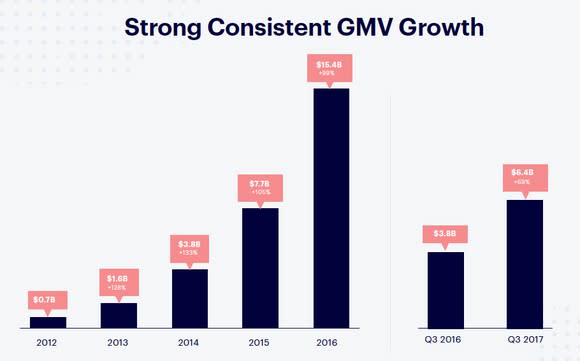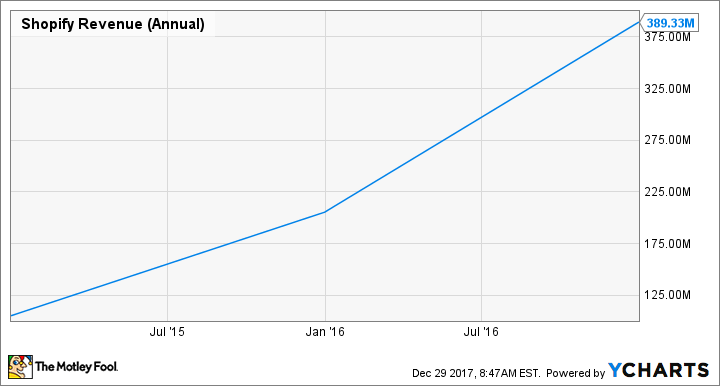Helping Merchants Reach More Customers Means More Money for Shopify
Shopify (NYSE: SHOP), an e-commerce platform company, is adding to the online places where its merchants can sell their products. You've likely heard of Amazon, eBay, and Facebook, but there are many other web properties that merchants are able to access with Shopify's platform and its partnerships. These give merchants different ways to expand their online presence, and as a result, contribute to Shopify's amazing revenue growth.
SHOP Revenue (Annual) data by YCharts
Shopify has been adding sales channels for its merchants over the last several years and now has integration with over 20 web properties for its merchants to find buyers.

Image source: Getty images.
Here's a sampling of key channels separated by year they were added to the Shopify platform.
2015: Pintrest, Twitter, Facebook, Wanelo, and Amazon.
2016: Facebook Messenger, Ebates, and Houzz.
2017: eBay, Buzzfeed, Kik, linkr, and Wish.
Shopify's merchants want to be where the buyers are, and the company is making it happen. You may not recognize all the online spaces and web properties above, but depending on the seller's products, these channels can be a huge opportunity to gain exposure to a new set of buyers.
More channels create more opportunity
Shopify makes it easy for its clients to sell products where they want. The merchant sets up its products once on the Shopify platform, and then can add sales channels via the Shopify app store. Each sales channel is different in the audience, how they work, and the fees. I'll cover three of these (Houzz, Kik, and linkr) briefly so that you can get an idea of the opportunity for Shopify's merchants.
Houzz is a marketplace for buyers interested in remodeling their house. The tag line for the site is "Get Inspired. Shop Products. Find Pros" and it boasts over 40 million active and engaged customers. The company is trying to build its brand; I saw a television advertisement for Houzz recently while watching a college football game. The Shopify app store says the Houzz app is free, but there is a 15% commission per sale.
Messaging app Kik has over 300 million registered users, mostly young millennials or teens. The platform lets sellers engage potential buyers through an intelligent "chatbot" that asks questions and responds to user input as if they are texting with a friend. The chatbot presents possible products for the buyers to consider. Shopify says items including clothes and beauty products are especially popular with Kik's young users. This program is free to Shopify customers until they sell something, then a 10% commission fee is charged.
linkr uses "social influencers" to promote a merchant's products on platforms such as Youtube, Pintrest, Facebook, blogs, and other channels. Merchants can load product descriptions and pictures onto the interface, which allows influencers and merchants to connect and create buzz for the merchant's wares. This platform is available in the U.S., the U.K., and German-speaking areas in Europe. Shopify offers this service via subscription starting at $150 per month; merchants pay the influencers and linkr takes a 15% cut of what they pay the influencer.
Growing gross merchandise volume
When merchants sell products through the Shopify platform, or one of the connected sales channels, this is tracked as gross merchandise volume (GMV) for Shopify, representing the total value of orders processed on Shopify's platform by its merchants, including shipping and taxes. In the most recent quarter, GMV totaled $6.4 billion, up 69% over the previous Q3.

Image source: Shopify.
Whether or not a merchant sells anything on the platform, the company gets a monthly subscription fee, but Shopify does better financially when member merchants' sales are growing. The amazing growth of Shopify's GMV is an indicator that merchants are thriving on the platform.
When merchants make a sale, Shopify takes a small fee and records it as merchant solutions revenue. This segment grew 72% in the most recent quarter, primarily driven by the healthy growth of GMV. Merchant solutions now makes up more than 50% of Shopify's total revenue.

Chart by author; data from Shopify.
Shopify has a virtuous circle that creates tailwinds for its business. As merchants sell more, the Shopify platform becomes a place to be for partner sales channels. New sales channels available to Shopify merchants provide different ways for entrepreneurs to grow their business. All of this enables Shopify to bring in more merchant services revenue and that's a formula that Shopify investors should love.
More From The Motley Fool
John Mackey, CEO of Whole Foods Market, an Amazon subsidiary, is a member of The Motley Fool's board of directors. Brian Withers owns shares of Amazon, eBay, Shopify, and Twitter. The Motley Fool owns shares of and recommends Amazon, eBay, Facebook, Shopify, and Twitter. The Motley Fool has a disclosure policy.

 Yahoo Finance
Yahoo Finance 
